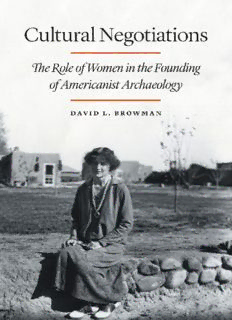
Cultural Negotiations: The Role of Women in the Founding of Americanist Archaeology PDF
Preview Cultural Negotiations: The Role of Women in the Founding of Americanist Archaeology
CULTURAL NEGOTIATIONS CRITICAL STUDIES IN THE HISTORY OF ANTHROPOLOGY Series Editors: Regna Darnell, Stephen O. Murray Cultural Negotiations The Role of Women in the Founding of Americanist Archaeology DAVID L. BROWMAN University of Nebraska Press | Lincoln and London © 2013 by the Board of Regents of the University of Nebraska All rights reserved Manufactured in the United States of America Library of Congress Cataloging- in-Publication Data Browman, David L. Cultural negotiations: the role of women in the founding of Americanist archaeology / David L. Browman. pages cm.— (Critical studies in the history of anthropology) Includes bibliographical references and index. ISBN 978-0-8032-4381-1 (cloth: alk. paper) 1. Women archaeologists—Biography. 2. Archaeology—United States—History. 3. Women archaeologists—History. 4. Archaeologists—Biography. I. Title. CC110.B76 2013 930.1092'2—dc23 2012049313 Set in Lyon by Laura Wellington. Designed by Nathan Putens. Contents Series Editors’ Introduction vii Introduction 1 1. Women of the Period 1865 to 1900 35 2. New Directions in the Period 1900 to 1920 73 3. Women Entering the Field during the “Roaring Twenties” 95 4. Women Entering Archaeology, 1930 to 1940 149 Concluding Remarks 251 References 277 Index 325 Series Editors’ Introduction REGNA DARNELL AND STEPHEN O. MURRAY David Browman has produced an invaluable reference work for prac- titioners of contemporary Americanist archaeology who are interested in documenting the largely unrecognized contribution of generations of women to its development. Meticulous examination of the archaeo- logical literature, especially footnotes and acknowledgments, and the archival records of major universities, museums, field school programs, expeditions, and general anthropological archives reveals a complex story of marginalization and professional invisibility, albeit one that will be surprising neither to feminist scholars nor to female archaeologists. This trend is consistent over the nearly eight decades that Browman explores, between the end of the American Civil War in 1865 and 1940, just prior to the vast postwar expansion of academic archaeology in North America. Only a few of the 148 women are familiar names. Minor figures abound as they do not in the history of cultural anthropology, generally a more solitary enterprise, and they give a peculiar and unique flavor to the professionalization of American archaeology. By identifying otherwise unrecognized women, this work sets a new standard of evidence for feminist archaeological historiography. The tracing of changing surnames reflecting successive marriages is espe- cially valuable because many of the contributors were not previously identified as the same women. For example, C(atherine) Allison Clem- ent [Withers] [Paulsen] used her middle name and was married twice; or Theodora Kracaw [Brown] [Kroeber] [Quinn], the second of whose vii three marriages was to cultural anthropologist Alfred Kroeber and who was better known as a folklorist than as an archaeologist; or the never married but nonetheless extensively named Frederica Annis Lopez De Leo De Laguna. Interspersed with the biographies and archaeological activities of these nearly forgotten predecessors are more extended evaluations of some of the rare women who “made it.” The discussion of Gene Weltfish is particularly instructive. Biographical vignettes are uneven, partly because of available evidence and partly as a result of the materials consulted over the huge range of possible materials for this study. It is refreshing to see a male archaeologist address the problem of marginalized women in archaeology given that exclusions and discrimi- nation are usually felt to entail some degree of complicity. Nonetheless, naming the problem is a step toward the future archaeology Browman envisions, in which gender will no longer determine the career trajectory of women in the field. Many of the women described here disappeared from archaeology but went on to distinguished careers in other fields (seemingly a source of some disappointment to Browman). During most of the period covered, the simplest way for a woman to become an archaeologist was to marry one, a route taken by many. Cross-reference is possible by culture area as well as individual, so readers can search for links to their own interests and specializations. The extensive bibliography shows where searches have been made and suggests directions for further investigation. Browman’s research expands outward from Harvard University and the Peabody Museum of American Archaeology and Ethnology, the home base of his own career and most intensive archival investigation; future investigators doubt- less will choose to pursue other tendrils of influence and participation. Documentary methods differ, however, depending on the decade in question because of the rapidly changing institutional basis of American archaeology during this 75-year period. In more recent decades, the number of women increased, and Browman’s more stringent criteria for inclusion reflect increasing professionalization. viii | Series Editors’ Introduction Some generalizations emerge, although the foremost purpose of this volume is documentary rather than analytic. Professionalization operated against women because it was harder for them to obtain the graduate credentials that were increasingly necessary for academic employment. The role of widows who came to control their own wealth as philanthropists who supported archaeology and encouraged women’s participation is especially fascinating: for example, Phoebe Apperson Hearst in California, Sara Stevenson in Philadelphia, Zelia Nuttall in Cambridge, and Mary Wheelwright and Elsie Clews Parsons in the Southwest. Edgar Hewett and Frederic Ward Putnam emerge as patrons of women in archaeology and facilitators of their participation, albeit often in minimally prestigious roles as lab assistants rather than active fieldworkers. The unabashed chauvinism of other male archaeologists is also noted, without apologetics. There is much more that might be said, but Browman’s book gives a clear starting point for documentation and invites interpretive scholar- ship across disciplines ranging from archaeology to feminist research to cultural studies. Such is the process of a critical history of anthropology! Series Editors’ Introduction | ix
Description: